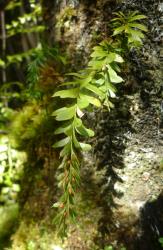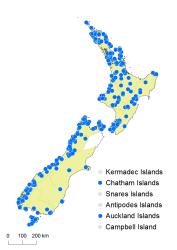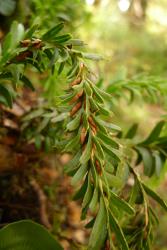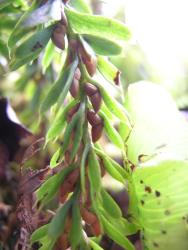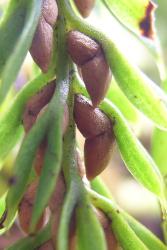- ≡ Lycopodium tannense Spreng., J. Bot. (Schrader) 1799(2): 267 (1800)
- ≡ Bernhardia tannensis (Spreng.) Müll.Berol., Bot. Zeitung (Berlin) 14: 221 (1856)
- = Tmesipteris fowerakeri H.N.Barber, Victoria Naturalist 71: 98 (1954)
Epiphytic or terrestrial ferns. Aerial stems pendent or occasionally suberect, 50–830 mm long, 10–45 mm wide, unbranched or occasionally 1-forked, of indeterminate growth eventually terminated by small sterile leaf or sporophyll. Leaves narrowly ovate, narrowly oblong or narrowly elliptic, rarely ovate, elliptic or obovate, straight or slightly sigmoid or falcate, spirally arranged, shiny green on upper surface, dull green on lower surface, brittle; the longest 7–28 mm long, 2–8 mm wide, usually at or below mid-stem or sometimes just above; apices emarginate, truncate, cuspidate or rarely acuminate, with a mucro 1–3 mm long. Sporophylls throughout, except in the lowermost part. Synangia 3–8 mm long, 1–2.5 mm high; lobes equal, usually strongly conic; the lower surfaces of each lobe rising away from their subtending leaf; the conic apices projecting upwards at maturity.
This is the most widespread species in New Zealand, recognised by its brittle, spirally arranged leaves, usually with truncate or emarginate apices and long mucro tips. The synangia are biconic, with the apices pointing upwards. It is also the species most commonly found growing terrestrially.
Some plants in Westland and the far south of the South Island tend to have broader, ovate to elliptic leaves, compared to the narrower, more elongate leaves elsewhere. They resemble T. obliqua from south-east Australia, but further work is required to confirm their identity.
North Island: Northland, Auckland, Volcanic Plateau, Gisborne, Taranaki, Southern North Island.
South Island: Western Nelson, Sounds-Nelson, Westland, Canterbury, Otago, Southland, Fiordland.
Chatham Islands, Stewart Island, Auckland Islands.
Altitudinal range: 0–1075 m.
Tmesipteris tannensis occurs throughout most of the North Island, except for some of the east coast. It occurs from sea level up to 900 m in the Urewera Ranges and Mt Taranaki, 950 m on Te Aroha, and over 1050 m on Mt Tauhara and Hauhungatahi. In the South Island, it occurs from the Marlborough Sounds through Nelson and the west coast to Southland and the Otago coast. There are only very scattered records from Canterbury, and it is absent from Marlborough and much of the interior. It ranges from sea level, reaching 950 m in north-west Nelson, and extends south to the Auckland Islands.
Tmesipteris tannensis usually grows epiphytically on tree fern trunks, but, unlike other species of the genus, it is also occasionally found terrestrially on banks, rocks, humus hummocks, mossy ground and peat mounds, or amongst matted roots and kauri litter. It is most commonly found on Cyathea dealbata, but also on C. medullaris, C. smithii, Dicksonia squarrosa, D. fibrosa and D. lanata. It has also been found on Dacrydium cupressinum, Griselinia littoralis, Ixerba brexioides, Podocarpus totara, Weinmannia racemosa, beech and Metrosideros trunks. It is sometimes found hanging from clumps of Collospermum and more frequently on rotting logs or dead stumps. It occurs in kauri, podocarp, broadleaved and beech forest.
On the subantarctic islands it has been recorded growing on the caudices of Chionochloa antarctica (CHR 323153) and under leatherwood scrub.
n = 104 (Brownsey & Lovis 1987).
Chinnock (1976) indicated that the holotype of Sprengel’s Lycopodium tannense had not been located, and was probably destroyed during World War II. Although Sprengel stated that it was collected on Tanna Island by the Forsters during Cook’s second voyage, Chinnock provided cogent reasons why this could not have been the case. Instead, he suggested that it was actually collected at Dusky Sound in New Zealand, and that the plant later illustrated by Bernhardi (1801) when creating his new genus, Tmesipteris, represented the species now known as T. tannensis. Bernhardi’s illustration was almost certainly based on a specimen from Sprengel’s herbarium. It was considered to depict the type specimen of Lycopodium tannense and was selected by Chinnock as the neotype. However, Fosberg (1993) challenged Chinnock’s choice, suggesting that a specimen in S, from the Swartz herbarium, might be from the Sprengel herbarium and that it should be used to lectotypify Lycopodium tannense. Unfortunately the original label has been lost, there is no indication that the specimen was collected by the Forsters, the identity of the specimen is uncertain, and there is no certainty that Sprengel saw it. Overturning Chinnock’s neotypification on the basis of this specimen therefore seems hard to justify.
Plants from Banks Peninsula (CHR 142562 and 397940) are very unusual in having leaves with acuminate apices, and require further investigation (Perrie et al. 2010).



